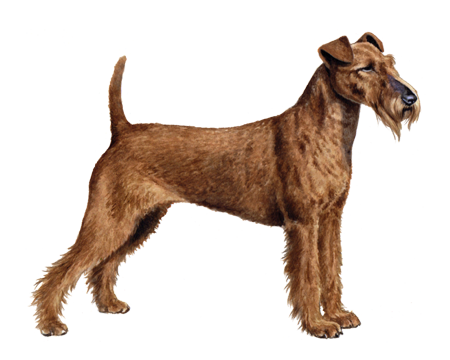
Kromfohrlander
Kromfohrlanders are intelligent and spirited dogs that make excellent companions and enjoyable pets. Always cheerful and affectionate, they're devoted to their families and like to stay close to home.
Interested in discovering if your dog is a Kromfohrlander?
Check out Wisdom Panel's DNA tests.

Kromfohrlander Traits
General Appearance
The wire-haired Kromfohrlander sports a distinctive beard and resembles its terrier roots. The smooth-haired variety is similar in appearance to a Spaniel.
Coat and Coloring
The wire-haired (Rauhaar) and smooth-haired (Glatthaar) coats on the Kromfohrlander are both medium-length. However, the smooth-haired variety tends to feature a longer coat overall. The standard coat for this breed features brown, tan, or "buff" markings on white, with a symmetrical blaze on the face.
Distinctive Physical Traits
A white blaze centered between the eyes of the Kromfohrlander is one of this breed's distinguishing characteristics.
Kromfohrlander Temperament
Kromfohrlanders are lively, good-natured, and intelligent dogs. Unlike some breeds in the terrier group, they have a low hunting drive. They are very adaptable and rarely stray from their owners.
This breed is pleasant, loyal, and enjoys hanging out at home with the family. Though they can be initially hesitant around strangers and children, these playful dogs make for lifelong friends once they warm up to people. The Kromfohrlander also makes a good watch dog and—like its terrier cousins—an all-star rat catcher.
As puppies, Kromfohrlanders need proper training and socialization, or they will test the limits of their owners.


Kromfohrlander History
A supposed descendent of a dog found by U.S. troops during World War II, the Kromfohrlander originated in Germany in the 1940s. The breed's name comes from the Krom Fohr area of Siegerland in Western Germany.
The Kromfohrlander likely arose from the crossing of a fox terrier and Griffon-type breed, which yielded two varieties of the same breed—one smooth-haired and the other wire-haired. The Kromfohrlander remains an exceptionally rare dog to this day.
Kromfohrlander Care
Nutrition
Kromfohrlanders can be finicky about what they eat. For this reason, they require high-quality food to maintain their weight and energy level. Though it's always important to keep an eye on how much food you're feeding your dog, it's unlikely you'll have to worry about this breed overeating.
Grooming
This breed typically sheds twice a year. You'll need to vacuum or sweep regularly to clean up fallen hair. But otherwise, these are clean, low-maintenance dogs with little or no smell.
Exercise
Kromfohrlanders would happily rest at the side of their people all day. However, regular outdoor exercise is important. This sporty and athletic breed loves to play and run.
Once Kromfohrlanders hit age three and their joints have developed, they can jump in the air for a frisbee. But a long walk in the woods seems to be their favorite pastime.
It's important to note that the Kromfohrlanders don't typically do well at a dog park. They prefer dogs they already know over those they don't—and the same is true about unfamiliar people and situations.
Training
Though a little independent, Kromfohrlanders are easy to train. They have a strong ability to focus and maintain attention. As a result, they can learn many tricks and will happily engage in long training sessions.
As intuitive, eager learners, Kromfohrlanders thrive with positive reinforcement.

Kromfohrlander Genetic Health Conditions
-
Hereditary Footpad Hyperkeratosis
Hereditary Footpad Hyperkeratosis (HFH) is a skin disorder, with disease signs including hard, thickened, and cracked footpads and an abnormal coat.
-
Hyperuricosuria
Hyperuricosuria (HUU) is a condition that predisposes affected dogs to the formation of urinary stones, such as kidney or bladder stones.
-
von Willebrand's Disease, type 1
von Willebrand's Disease (vWD) Type 1 is a blood clotting disorder that typically causes mild bleeding tendencies although some affected dogs may have more severe signs. It is the result of low levels of von Willebrand's factor, a blood protein that helps stabilize blood clots.
Knowing if your Kromfohrlander is a carrier or at-risk for these conditions can help you and your veterinarian plan for your pup’s lifelong care. With Wisdom Panel™ Premium, you can get results for over 200 genetic health tests.
Breed Group
Terrier
The Terrier Group ancestors were bred to hunt and kill vermin. They are often characterized as feisty and energetic dogs whose sizes range from fairly small to much larger.
Resources
https://www.akc.org/dog-breeds/kromfohrlander/
http://www.kromiclub.com/faq.html
https://www.google.com/books/edition/The_Dog_Encyclopedia/ZWLyAAAAQBAJ
Reviewed July 26, 2020 by Cindy Elston, DVM, MPH





















































